--
Romantic Heritage of Victor Valley
by Burr Belden - 1969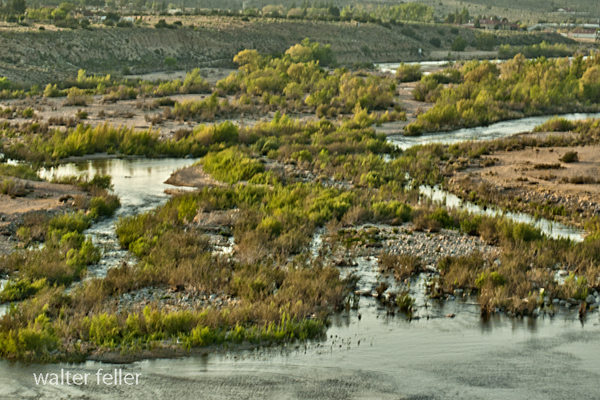
Mojave River
BEGINNING as early as 1772, a colorful pageant of humanity traversed the natural pathway along the Mojave River through what is now Victor Valley. Here rode Spanish governors, devout missionary-priests, buckskin-clad trappers and frontier traders. Here passed the Ute horsemen who made horse thievery big business. On their heels came avenging ranchers and soldiers. Then in the later 1840's, the covered wagons began cutting ruts on the trail. Swaying concord stage coaches, desert freighters heavily-laden ore wagons, and even a survey party equipped with camels, passed in review at the narrows of the Mojave, setting the opening scenes for the modem pageantry ushered in by the iron horse in the mid-1880's.
Mining, agriculture, industry, business, highway travel, residential and resort development followed one after the other during the intervening years, transforming this once isolated desert region into one of Southern California's fastest growing areas.
The story of Victor Valley might well be started 5,000 or more years ago when primitive man dwelt in caves in several parts of the Mojave Desert. When the first white explorers came, however, the earlier races had moved on. The foothill region, including Summit Valley, Baldy Mesa and Hesperia, was dotted with rancherias, little collections of brush huts peopled by the Serrano Indian, a Shoshonean branch that had lived at peace so many generations it had all but forgotten warfare. Farther out to the north lived the Chemheuvi, a Paiute branch, with settlements in the Hinkley area. The Chemheuvi were of a far different strain from the Serrano and by the time the flag of the United States had displaced that of Mexico, the peaceful Serrano had been pushed back into the mountains and the more warlike intruders roved back and forth across Victor Valley.
This was the scene when the commander of California's Spanish forces, Pedro Fages, made the first recorded visit to the area in 1772. Fages, who was later governor of the province, was chasing deserting soldiers from the San Diego presidio. The deserters had slipped east over the Colorado desert farther south, and Fages let them go. He had become intrigued with the vast inland valleys of California. Fages crossed the San Bernardino Mountains, possibly by way of Lytle Creek and Horse Canyon. He wrote about Joshua trees, which he called palms.
Nearly four months before the Declaration of Independence was signed in far off Philadelphia, in 1776, a devoted missionary priest, Francisco Hermenegildo Garces, came overland from the vicinity of Needles, accompanied by a Mojave Indian guide and an Indian servant, Sebastian. Garces, astride a mule, held the first Christian service in the area, at an Indian rancheria near the present site of Hesperia.
After Garces, in 1806, came Fr. Jose Zalvidea on an exploratory trip from the Santa Barbara mission. He paused at a rancheria near Summit Valley where he baptized five Indians, the first Christian converts of record.
While Spain was leisurely peopling the coastal valleys of California with colonists who almost overnight became land barons with vast herds of cattle and horses, the restless Yankee was pushing westward over the Mississippi, the great plains and the Rocky Mountains. In the vanguard of this expansion was a buckskin-clad phalanx of sure shooting trappers intent on catching beaver. A leader of one American fur firm was a devout Methodist, a man of far different type than the usual trapper. This was Jedediah Strong Smith, who pioneered a trail west from the vicinity of Salt Lake and reached the Victor Valley in 1826. His men trapped for beaver up the San Joaquin. In 1827 Smith was back, this time in flight for his life. Mojave Indians. near Needles, had slain all but ten of Smith's men and he raced for help to the mission outpost in the San Bernardino Valley.
The second Smith entrada in 1827 is of interest because, instead of following the winding Indian trail over the mountains via Cedar Springs and Sawpit Canyon, it headed directly south from the Mojave Narrows at Oro Grande, and became the first to blaze the Cajon Pass gateway.
After Jedediah Smith came visitors of a far different stripe, marauding Ute Indian bands headed by the war chief Walkara, who turned the Cajon into the "Horsethief Trail" and left that name on two canyons. Walkara's irregular and hard riding cavalry cut out 3,000 horses in his 1840 raid. although it reached Utah with only one-fifth of the herd, so strongly did the Mexican ranchers press the pursuit to the vicinity of Daggett.
The romantic figure of John Charles Fremont, the pathfinder, crosses the horizon accompanied by such notable scouts as Kit Carson and Alexis Godey. Fremont, scoutin-g the West and preparing the maps of the passes, paused on the Mojave to redress the slaying of a peaceful New Mexican trader who had been a member of a colorful commerce caravan plying between Santa Fe and Los Angeles.
The Mexican trade caravans were a yearly venture in the 1830's and 1840's, with arrival in California during the fall and return to New Mexico in the spring. In 1846 the United States took California and a major army unit, the Mormon Battalion, garrisoned Cajon Pass to effectively halt the horse thieves for the first time. Once discharged, a group of this battalion's soldiers returned to their Salt Lake families via the Cajon and the old trail to Santa Fe. With them rolled a wagon - the old pack train trail thereby becoming a highway for wheeled vehicles.
Gold, gold at the forks of the American River was discovered in 1848. By 1849 half the nation was either moving or wanting to move to California. Among the overland argonauts were many who reached Salt Lake too late in the season to chance completing the trip via central Nevada. Snow, deep snow, would block the Sierra Nevada passes before they could get through. Rather than winter in Salt Lake, where provisions were scarce, one of this group hired a former Mormon Battalion captain, Jefferson Hunt, to guide them over the southern route through what is now Victor Valley, then down the Cajon Pass to Los Angeles. This was the famous Death Valley party. After great hardship, all but four or five reached Los Angeles on foot.
Settlement followed the gold rush. In the spring of 1851, a caravan of 500 homeseekers from Salt Lake came through Victor Valley and founded Southern California's first English-speaking communitv - San Bernardino. From then on, this desert area was no longer. a remote land. Every month saw passing families and traders. Mail service followed, then army garrisons and stage coaches.
The 1851 San Bernardino colonists had followed the Old Spanish Trail up the Mojave past what is now Victorville and Hesperia and into the Cajon via Summit Valley. In 1852 a short cut was tried over Baldy Mesa. In 1853 gold was being mined out at Salt Spring (north of the present Baker ) and Phineas Banning sent his brother-in-law out to the mines with machinerv. William Sanford, the brother-in-law, found the road suitable for emigrant wagons but not for machinery. He pioneered a new route from West Cajon to Oro Grande.
In 1860 gold was discovered in Holcomb Valley and that community's principal town, Belleville, became for a time the Southern California metropolis. Holcomb Valley was remote, however, and a pack trail up Santa Ana Canyon was its only thread of communication with the outside world. When miners needed a boiler and steam engine, a new road was required. This was built down Holcomb Creek and over Coxey Meadows by the town blacksmith, Jed Van Dusen. He was paid $2,000 in gold dust. The road ended at Deadman Point, then moved northwestward over the southern part of Apple Valley to Verde Ranch. At Verde it connected with the "Brown" turnpike.
The "Brown" turnpike was a toll road built by John Brown, Sr., through the East Cajon under a 20-year franchise granted in 1861 by the state legislature. It ended at the Verde Ranch, where John Brown, Jr., had homesteaded. With the Brown road improvement, a new and shorter route was pioneered through to the Barstow area, approximating the present Stoddard Well Road.
The old road down the river had utilized the lower narrows, near Oro Grande, for its crossing. There a somewhat eccentric ex-army captain, A. G. Lane, had a station and store. In the flood of 1862, his station became an island for weeks. Farther down the river, an old adobe grocery was located near the present Helendale. Lane's and the old grocery were the only settled places until the Verde Ranch was established.
Mines were found east of Victorville and at Oro Grande, where Meeker and Johnson erected the first mill on the river. The Oro Grande mill, incidentally, refined the first ore from the fabulous Calico discovery of the 1880's. Later it was moved to the Calico area.
In the mid-1870's, Meyerstein Brothers of San Bernardino ran a weekly stage to the silver city of Panamint, their route following the Brown road through the Cajon Pass, along the Mojave River to Helendale, then it blazed a new road north to Hinkley.
The year of 1885 was cause for unprecedented celebration. The first train of the Southern California Railway, a Santa Fe subsidiary, passed through the Cajon Pass from San Bernardino to Barstow. More than thirty years before, the first railroad survey was made by Lieutenant R. S. Williamson, a government engineer who had determined that the only route through the Pass called for a 3.4 mile tunnnel through a hogback in West Cajon. It was started in 1875, but only a mile was dug and the tunnel was abandoned for lack of money. Later a Santa Fe survey decided upon the present route through East Cajon, necessitating only a simple cut-through.
The coming of the railroad changed the complexion of Victor Valley. The boom was on. Towns blossomed along the railroad line where there had been only grazing land earlier.
Since the discovery of gold, silver and copper mines in Holcomb and Bear Valleys in the San Bernardino mountains, prospecting had spread throughout Victor Valley and mining activities had continued through the ensuing years. In the 1910-1920 decade. however, non-metallic mining came to the fore, in the production of lime and cement, and this continues to be the Valley's major industry. With the advent of the railroad. barren lands which had been devoted to cattle grazing were taken over, in part. by farms and orchards. Farming, cattle and turkey ranches and kindred activities continue to be an important economic asset.
The paving of the National Old Trails Highway from Cajon Summit to Victorville in 1922 gave further impetus to the increasing importance of Victor Valley. Although the growth of this area had been steady, it did not come into its own until after World War II, when it began receiving its share of the vast number of newcomers migrating to California. This onrush continues unabated.
Although the high desert had always been known for its fine and healthful climate, the widespread recognition it has received during the past several years accounts for its unprecedented residential expansion and the creation of resort communities ranked among the finest in the West. Of tremendous importance in the maintenance of a balanced economy in Victor Valley is the existence of the huge George Air Force Base, with a personnel of over 5,000.
In Victor Valley, this is an era of freeways and air travel . . . of an ever-expanding population, business, industrial and recreation development which presents a challenge even greater than that faced by the pioneers over the past 100 years.
VICTORVILLE
Honoring Jacob N. Victor, construction superintendent of the Santa Fe through the Cajon, the name Victor was given to the railroad's telegraph station and "Y" built a mile northwest of the upper narrows of the Mojave. When the trains came through, probably the only buildings in this area were the Rogers log cabin on the east side and the J. C. Turner ranch to the north.This railroad activity was. basis enough for the starting of a small community. A store or two, blacksmith shop and two saloons east of the tracks became the neucleus of a business district which gradually expanded westward. During the surrounding mining activity, the community boasted one of the finest gold stamp mills.
In 1901, the post office changed the name to Victorville, claiming there was confusion with Victor, Colorado. Victorville had become the largest community and trading center in Victor Valley, benefitting from increased railroad and road travel, mining and agriculture. In the 1910's and 1920's, Victorville and its "wild west" back country were used for more than 200 movie films.
The industrial future of Victorville was assured with the erection in 1917 of the Southwestern Portland Cement Co. plant and this has remained as its leading industry.
Victorville's growth kept pace with that of Southern California during the years that followed. The great surge forward developed immediately after World War II, when smog free desert climate in the high elevation Mojave attracted more and more newcomers. It was inevitable that resort communities would come into being, thus augmenting the economy of Victor Valley. The past ten years has witnessed Victorville's greatest population growth and the expansion of its business and distribution facilities. It is the home of the San Bernardino County Fair, and thousands view the exhibits and the R. C. A. Championship Rodeo.
APPLE VALLEY
Once called "Happy Valley" by the Indians, Apple Valley derived its name from the apple orchards planted years ago by early homesteaders. The orchards were largely abandoned during the depression years.Space does not permit recounting all the historical events which preceded settlement. With the discovery of mines in Holcomb Valley in the San Bernardino Mountains, prospectors traced their way through this valley over what is sometimes called the Old Government Trail.
Today, Apple Valley is one of Southern California's most colmful desert resorts. Within a space of a few years, this planned community has witnessed tremendous growth, its extensive shopping center, beautiful inn, motels, golf course, airfield and ranchtype residential development attesting to its magnetic appeal for those seeking the superb desert climate and outdoor environment.
HESPERIA
In 1885, a signpost on the new railroad line read "Hesperia," a name possibly borrowed from the old Roman idiom "to the West." Reminiscent of the land boom started in 1886 bv the old Hesperia Land and Water Company are crumbling remain"s of the famous Hesperia Hotel and nearby, the first public building erected in 1887, which housed a store, hotel and post office. It is still occupied.Amid the Joshua trees, a new Hesperia has risen, with miles of paved streets, lovely homes, golf courses, picturesque inn, motels, airfield, dude ranches and a modern business district. Here, on a mesa that witnessed the historic parade of pioneers traversing the rugged trails along the Mojave, a resort community is gaining greater renown each day ... offering western living at its finest.
LUCERNE VALLEY
In the early 1880's. a miner trail up Cushenbury Canyon was improved to handle freight wagons with supplies for building the first dam at Big Bear Lake. A few years previously, Al Swarthout had started a cattle outfit named Box S, and when this was sold to James Goulding, it became a desert crossroads. Here, and at Rabbit Springs, a pioneer oasis nearby, shallow water. climate and soil were found to be ideally· suited for alfalfa. Later, both became place names and Lucerne· was officially adopted, it being the European name for alfalfa.In addition to its farming, Lucerne Valley claims the title of being one of California's dude ranch capitals. It is the nearest community to the huge Permanente Cement Plant.
ORO GRANDE
From its pioneer gold mining, Oro Grande became typed as an industrial community and such it has remained. When the railroad came through in 1885, Oro Grande found its name changed to Halleck, and it bore the latter name until 1926.Before the turn of the century. lime kilns were erected right on the site of the present modern plant of the Riverside Cement Co. Along with its cement industry, farming has prospered.
HELENDALE
When the railroad arrived in 1885, the station was known as Point of Rocks. This was changed to Helendale by a Santa Fe executive in honor of his daughter, who was named Helen. Helendale's farming center was referred to as "shallow water," an apt one for the broad Mojave Valley bottom lands where ranchers could raise repeated crops in the warm summer days. and where cattle thrived. Helendale's entries at the annual County Fair attest the excellence of its agricultural advantages.ADELANTO
E. H. Richardson. inventor of the Hotpoint electric iron, turned a sizeable mesa into a small farm community in 1917. He named it Adelanto after the Spanish "progress" or "go forward." It is situated on U. S. Highway 395, a major artery of travel. Adelanto gained new importance during and since "World War II by the operations of nearby George Air Force Base.Residential development continues to expand rapidly, not only to provide housing for the families of the base personnel, but to meet the demands of newcomers.
These and other communities reflect the spirit of progress which pervades Victor Valley. There is Phelan, changing from a homestead center to one of leisure living, new communities west of Baldy Mesa, and other developments. All are in the land of the Joshua tree, the hallmark of California's high desert- the Mojave.
ALTHOUGH
Although the modern history of California Interstate Telephone Company dates but from 1954, its origin traces back half a century to pioneer companies which formed vital segments of the system. Some had their humble beginnings during the rugged formative days of booming mining camps. Mining activity attracted two Denver men to Western Nevada in 1904. Unsuccessful in finding promising claims at Tonopah and Goldfield, their attention turned to possibilities of developing hydroelectric power on Bishop Creek, in the Sierras to the west, to supply the mines.Subsequently, in 1905, The Nevada Power, Mining & Milling Company was organized and became the first in a line of power company entities. During the year an initial telephone line was constructed paralleling the first power transmission line from Bishop Creek, via Silver Peak, to Tonopah and Goldfield, serving the power company for internal communications purposes.
In October 1910, Interstate Telegraph Company, predecessor to California Interstate Telephone Company, was originally incorporated.
Control of the new company was acquired by power company associates in 1911 and a single communications system formed. Composed of power company communication facilities within Nye and Esmeralda Counties, Nevada, and Inyo and Mono, in California, plus a line under construction to the south within the additional California counties of Kern, San Bernardino and Riverside, Interstate commenced operations on March 1, 1912.
Over the years service boundaries have drastically changed. To the south, telephone lines followed construction of power transmission facilities. By late 1912 service was established at Victorville, fifth exchange on the system. Access to the nation's communication network was provided with connection at San Bernardino. Early in 1913 telephone service was extended to Oro Grande. And in May 1927 the initial line to the Apple Valley region was constructed. At the close of 1927, 105 telephones were installed within the exchange.
Automatic dial service was established at Victorville in January 1928. The new dial service was followed, in March, by absorption of a private telephone system at Adelanto, extending distribution lines throughout this locale for the first time. Lucerne Valley received service next, with a line completed a year later, in April 1929. Temporary service was supplied George AFB in July 1941; permanent lines terminated at the field in November. The Hesperia region received exchange service during 1944. Satellite offices at Adelanto as of '49, Apple Valley from '55, Hesperia in '63 and Desert Knolls late in '67 presently complement the central office at Victorville and establish the Victorville Exchange as the largest on the system, with some 19,897 stations as of November 1968.
Growth prompted formation of a separate exchange at Lucerne Valley in March 1962. At the time, 249 telephones were connected to the new Lucerne Valley Central Office. Currently, almost ";"00 telephones are included in the Lucerne Valley Exchange.
California Interstate was incorporated in January 1954 and acquired the business and assets of Interstate Telegraph Company. Subsequently. in June 1965, California Interstate became part of the Continental Telephone System.
Headquartered at St. Louis, Missouri, Continental Telephone Corporation now represents the third largest independent (nonBell) telephone company in the United States, with operating properties in 40 states, including Alaska, in Canada, the Bahamas, Jamaica and Barbados in the West Indies. A manufacturing arm has been added to the growing Continental operations.
Throughout these service areas growth is continuing at a rapid pace, making Continental Telephone Corporation one of the fastest growing independent telephone companies in the nation.
WITH a past rich in historical romance and tradition, it is obvious that the communities of Victor Valley are on the threshhold of an equally colorful future - one promising unprecedented advancements, yet retaining all the unspoiled charm which is prized so much.
The family of Continental Telephone Corporation is proud that it has, in certain measure, been a part of the development of this area and it looks forward to greater participation in the years to come.
This history portrays, in brief form, the transition of this area from its earliest davs to the present. This company, in its efforts to cooperate with the communities it serves, hopes this booklet may be a source of enlightenment to both residents and visitors.


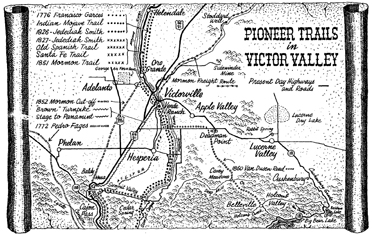

Fr. Garces
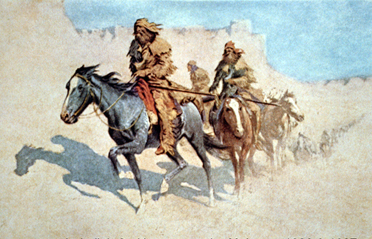
Jedediah Smith - Remington
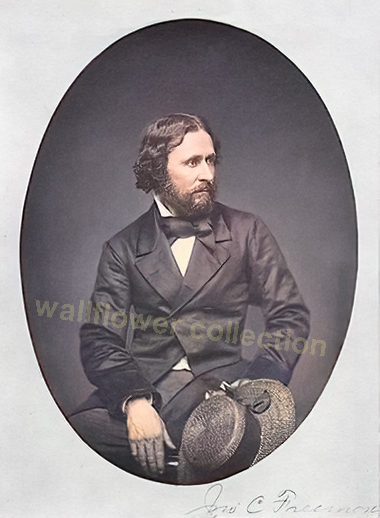
John C. Fremont
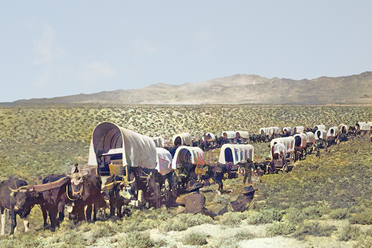
Wagon train
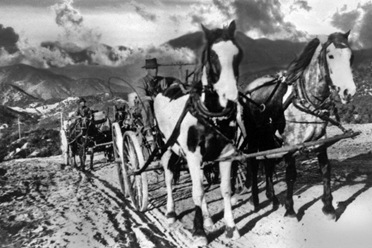
Wagons at Cajon Summit
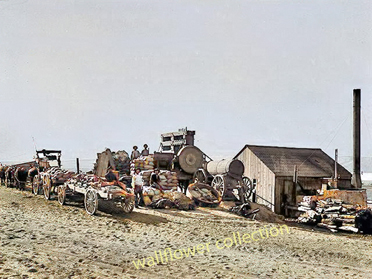
Oro Grande Mill
-c-wallflower-.jpg)
North Verde Ranch
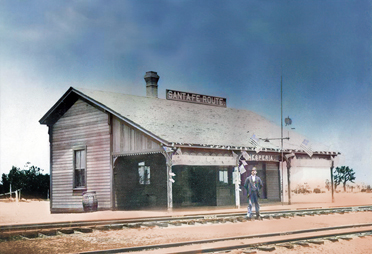
Santa Fe station, July 4, 1897 - Hesperia
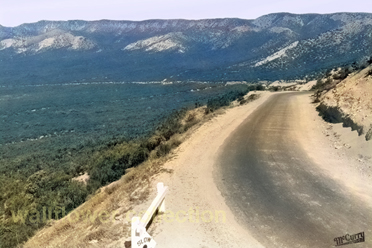
National Old Trails Road - Cajon Pass
-c-wallflower.jpg)
San Bernardino County Fair, Victorville, Ca.